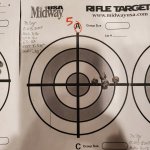I just did a seating depth test on some loads I worked up. 5 test groups of 5 rounds each, ranging from .015" to .035" in .005" increments. I did this twice for two slightly different charge weights (so, 50 rounds total). The lower charge weights were groups 1-5, the higher weight 6-10. I'm not the world's best shot, so for load testing, I measured the group based on the best 4 shots, since some of the flyers were inevitably my fault. For measuring vertical spread though, I used all 5 shots, since when I pull one, it's (usually) left or right. Chrono'd with a Lab Radar. FWIW, I rarely get the <5 ES's and <2 STD's that I see people talking about here all the time, so I'll have to live with a little more tolerance than some of you guys out there.
Here is a picture of all 10 groups, followed by some close ups of the ones I thought might be the one to run with.




Group 7 was my initial thought for a winner. It certainly had the smallest (4 shot) group size, one of the smaller vertical spreads, the only single digit SD, and the best ES (although the Lab Radar only recorded 4 of the 5 shots). That said, group 8 had pretty good speed metrics (and recorded all 5 shots), had a significantly smaller vertical spread, and although the group size was bigger, the fact that it has two bugholing groups suggests that maybe it was me pulling a couple of shots (consistently), and not the load. Had I not done that, those might all be one hole... maybe worth another try. Group 10 also had decent (for me) chrono numbers, and worth noting (I thought) was the fact that 4 out of the 5 shots had a vertical dispersion of only .019"... barely anything. I wonder if that one might be worth another look as well.
On the lower charge weight, Group 5 did alright on paper and on the chrono, but didn't look quite as good to me as the three above. Group 1 also had a decent best 4 group size, but the chrono numbers were some of the worst I recorded, and the vertical spread was better on the groups pictured above.
So... what say you all? If this is what you had to work with, which would you run with?
Here is a picture of all 10 groups, followed by some close ups of the ones I thought might be the one to run with.
Group 7 was my initial thought for a winner. It certainly had the smallest (4 shot) group size, one of the smaller vertical spreads, the only single digit SD, and the best ES (although the Lab Radar only recorded 4 of the 5 shots). That said, group 8 had pretty good speed metrics (and recorded all 5 shots), had a significantly smaller vertical spread, and although the group size was bigger, the fact that it has two bugholing groups suggests that maybe it was me pulling a couple of shots (consistently), and not the load. Had I not done that, those might all be one hole... maybe worth another try. Group 10 also had decent (for me) chrono numbers, and worth noting (I thought) was the fact that 4 out of the 5 shots had a vertical dispersion of only .019"... barely anything. I wonder if that one might be worth another look as well.
On the lower charge weight, Group 5 did alright on paper and on the chrono, but didn't look quite as good to me as the three above. Group 1 also had a decent best 4 group size, but the chrono numbers were some of the worst I recorded, and the vertical spread was better on the groups pictured above.
So... what say you all? If this is what you had to work with, which would you run with?

